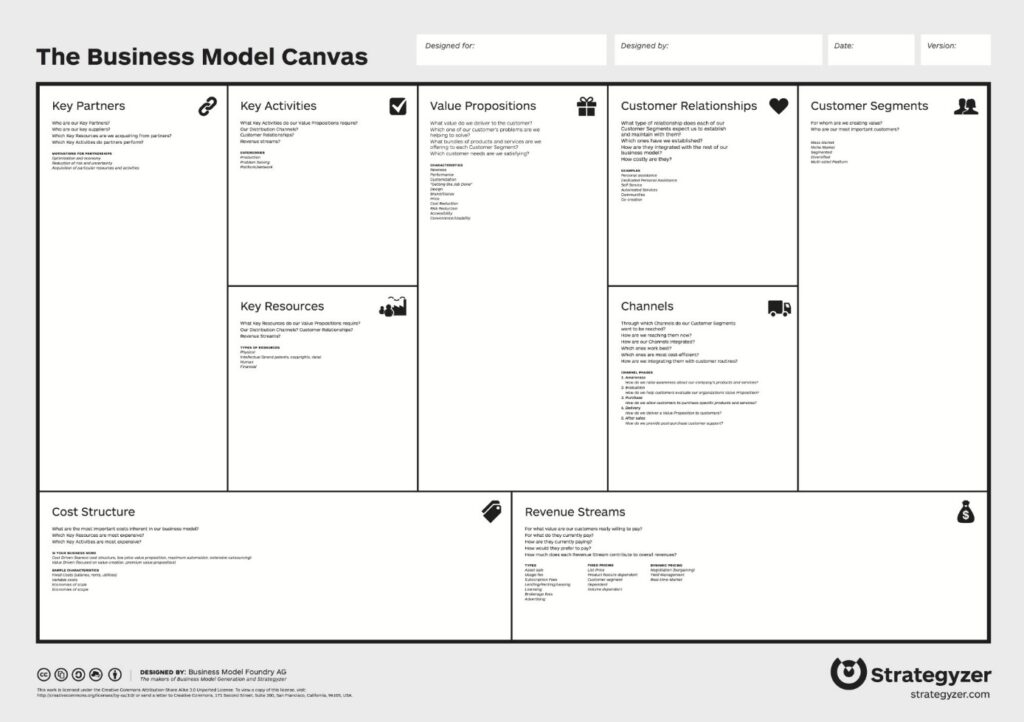The “Business Model Canvas” published by Alexander Osterwalder and Yves Pigneur in 2010 is a pragmatically conceived procedure with which you can describe, document and critically question, supplement and optimize your business model.
The charm of the Business Model Canvas is that the underlying principle is universally valid and can be applied to all industries and all company sizes. The method is suitable for company founders as well as for managers of established companies.
It is particularly suitable for management teams to develop a common understanding of their business model and to visualize the interrelationships.
The Business Model Canvas guides you systematically through the development of a coherent business model.

First, you will be asked to name your target customer segments and describe their relevant needs as precisely as possible. (At this point, you could at least mentally perform a buyer personas analysis. Many companies don’t actually know their customers. Do you really know your customers? Who in your customers’ organization makes the decision to buy? Who influences the purchase? Who uses your service? What needs do these people have? What specifications do these people expect?
Then you will be asked to formulate your value proposition to these target segments. Make sure that your value proposition exactly meets the needs of your target segments. When you enter your current offer, you will find out at this point whether you “hit the mark” with your offer or whether you should make adjustments. Do not discard conclusive proposals because you see implementation problems. It is important that you proceed strategically. The effort to realize implementation opportunities is often less than the lost business opportunities due to a fuzzy business model.
The next question is which channels you want to use to address your target segments with the required reach and target customer focus. This is part of the strategic positioning process. It is about communication channels for marketing and PR as well as sales channels, i. e. sales structures. To answer this question, you should identify which channels your target segments use and which of these channels are suitable for communicating and selling your offering. Think about the question of direct sales versus multi-level sales. Mentally break free from the way things are done in your business today. This is an opportunity to rethink your business model in a completely free way and, if necessary, revolutionize it. Also, at this point, think from the outside in, in concepts, not in implementation steps. Otherwise, you will be immediately biased and limit yourself mentally.
Now consider how to develop and strengthen business relationships with potential customers in your target segments (customer relationships). This question is complex. Who from your organization or channel has personal contact with people at your customers? How are the relationships with different people at your customers “orchestrated”? At what level do conversations with customers take place? Is it a pure supplier relationship? Do your customers involve you in future topics? Are you talking at a strategic level? In order to develop customer relationships, a “Large Account Management Program” (LAMP) according to Miller Heiman is a good idea for large companies with high-potential customers.
For smaller companies, a simpler but also effective approach is sufficient. A corresponding form can be found at ?Customer Relationships?.
Do not overestimate the customer relationships of your sales representatives and salespeople. If you are a salesperson or sales representative, critically examine your customer relationships, and systematically build them.
Now consider how best to organize payment streams from your offerings to your target customers through your chosen channels. Which service is your main source of revenue? Which ancillary services can generate revenue? Which revenue model is appropriate for your business? A sales model, a rental model, a flat rate model? What is the pricing? What terms and conditions are appropriate?
Next, turn to the activities that need to be performed to create the offer and sell it to your customers. Focus precisely on the activities that are required to fulfill this goal and consistently separate yourself from all other activities. One exception is important: don’t limit your scope of possibilities in the process. Keep your organization flexible and adaptable to identify and respond to changing customer needs.
To be able to perform these activities, you now systematically derive from your offer who you need to create this offer and sell it to your customers. What key resources do you need? Define the requirements for these key resources and check whether the resources you are currently using really meet these requirements. How can you develop the resources further? Should you replace certain resources? Which of these key resources should you have under your own control? Which of these key resources should you be able to access securely without holding them yourself? How do you contractually or factually secure access to these resources? What partnerships are important? Mentally walk through these steps and then boldly implement your conclusions.
Finally, merge the expected revenues with the costs of the activities. This will result in your business plan, which emerges from a coherent business model. Specially when founding businesses a business plan is very useful.